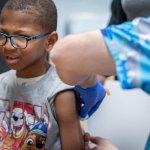UK Prime Minister Boris Johnson has announced an ambitious “moonshot” plan to roll out mass population testing for COVID-19. Johnson said that, under the plan, the UK would process millions of tests a day, allowing those who test negative to resume their normal lives. The programme will cost around £100 billion, equivalent to two-thirds of the annual budget of the National Health Service.
Will it work? Unfortunately, mass population testing is a flawed idea in search of science to back it up. It is unlikely to be the solution that sees us out of this pandemic.
No test is perfect
The purpose of COVID-19 mass testing is to detect people who are infected so that disease control measures such as quarantine and contact tracing can be undertaken to break the chains of transmission.
This critically depends on how good the test is. There is no such thing as a perfect test – every type will generate false positives and false negatives. The amount of false results generated depends on the characteristics of each test, as defined by their sensitivity (how accurately they identify cases), specificity (how accurately they identify non-cases) and predictive values (how likely you are to have or not have the disease if you test positive or negative respectively).
Let’s look at the gold standard test: reverse transcriptase polymerase chain reaction (RT-PCR). This tells you whether the genetic material of the virus that causes COVID-19 is present, but it won’t necessarily tell you if you are currently infected or have a re-infection. It can’t tell whether it is a past infection but you are still shedding bits of virus (indeed studies have shown some people shed viruses for many weeks). And despite having viral genetic material present, the test does not tell you if you’re infectious.
The accuracy of RT-PCR tests are affected by what samples are taken, ranging from 93% for specimens taken from air passages of the lung, down to 32% for a simple throat swab. It is also affected by how the samples are taken, stored, transported and processed. Contamination at any stage can give you a false reading. Whether a test detects viral infection also depends on the stage of the disease and the person being tested. Some infected people might shed lots of virus, others less.
There are other types of types of test, such as, antibody tests, which are currently being used but which also have limitations and issues with accuracy. There is the possibility of cross-reactivity with other viruses with antibody tests. Antibody tests are less sensitive, especially early in the disease as there may be insufficient antibody response to be detected. Later on, antibody levels may fade and again be undetectable. And even if antibodies were detected, interpretation is tricky – is it a recent infection or past infection? We can’t tell.
The predictive value of the tests also depends on the prevalence of disease in the community. When disease prevalence is low, we are more likely to get a lot more false positives. Indeed, if you have a positive test, it may be that you don’t have disease. When disease prevalence is high, the predictive value improves and test results are more likely to be accurate. What that means in practice is that if a million people were tested, there is the real possibility that tens of thousands will get erroneous results.
Why it matters
Test accuracy matters – a lot of false positives can create anxiety for people affected and leads to unnecessary restrictions on them, their households, schools or workplaces. It also generates a lot of work for public health protection teams who have to investigate each case.
False negatives are more worrying, as affected individuals who may be infectious are falsely reassured. They will continue with their lives, potentially relax their infection control behaviours, and infect others. These erroneous results are likely to undermine public trust in the testing system.
Another fly in the ointment is the frequency of testing required. A person could be tested negative on one day, contract an infection from an infectious person the next day, and be themselves infectious within a week. If they had an infection with no symptoms, they could unwittingly continue to spread the disease until they had their next test.
Unintended consequences
There are practical considerations at every step of the way for any national testing program. Who’s administering the test? What personal protective equipment and support infrastructure do they need? Who transports the specimens? Who processes the specimens? How are they safely disposed of? How are results managed? How are the results interpreted and fed back appropriately to individuals? How will positive results be notified to public health authorities?
Mass testing also requires a lot of infrastructure and personnel. In the UK, we have limited clinical workforce. There is an opportunity cost inherent in diverting these limited clinical resources away from other activities. Which does one consider more important – childhood vaccinations, cancer screening, diabetes management, or swabbing activity of low-risk individuals for COVID-19? The solution might be a do-it-yourself test, but a good enough version of this has not yet been developed.
As a system we have to ensure equitable coverage of services and care for the whole population – the sick, the people with disabilities, the elderly, children, care home residents and others. Decisions for one group may have unintended consequences for another. We have to be mindful that our actions don’t have disproportionate and harmful effects elsewhere in the system leading to sickness and death in non-COVID sectors.
It is worth noting that a test in itself is not an intervention. People who have been identified to be possible cases of COVID-19 through testing need to isolate and take necessary precautions. Worryingly, one study in the UK found that less than a quarter of people with COVID-19 symptoms followed isolation and lockdown advice. Public support and compliance with these measures is therefore vital. Even if mass population testing is rolled out, it is unlikely to work without the buy-in of the public.
We know what works in fighting coronavirus – keeping our distance, using face coverings, frequent hand washing and avoiding crowds, close contact, and confined spaces. Having an effective contact tracing system as well as a support system for those who have to self-isolate is also important. The protective effect of all these measures are additive – so do it all.
Andrew Lee has previously received research funding from the National Institute for Health Research. He is a member of the UK Faculty of Public Health and the Royal Society for Public Health.








